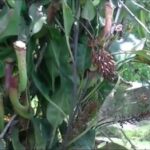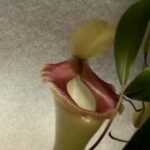As an Amazon Associate, this site earns commissions from qualifying purchases. For more details, click here.
Endemic to Indonesia, the word jamban is Indonesian for toilet, which is not surprising given its appearance. Others think its pitchers look more like a bell. What everyone can agree on however, is that nepenthes jamban looks striking and unique. The other nice thing about this highland pitcher plant is that you can grow it without too much difficulty.
Nepenthes jamban needs bright, indirect sunlight and 75-80% humidity. The daytime temperature should be 75-80 F and around 55-63 F at night. Use only purified water to moisten the soil and you must protect the plant from frost.
Nepenthes Jamban Care Sheet
| Soil | 3 parts fiber sphagnum moss and 1 part perlite |
| Water | Distilled or spring water |
| Light | Bright indirect light, sunlight or grow lights |
| Food | Mealworms, fish food, insects |
| Temperature | 75-80 F / 24-27 C |
| Humidity | 70-80% |
| Dormancy | Not needed |
| Propagation | Stem cuttings |
Soil
The typical mix consists of 3 parts long fiber sphagnum moss (LFS) and 1 part orchid bark or perlite. You may also use peat moss and perlite or LFS and silica sand. A soil mix of vermiculite, perlite and silica sand is also good.
Your plant should come with its own soil mix or suggestions on what to use. Once you gain enough experience you can try other potting media combinations. Some nepenthes may prefer one mix over the other, so you have to find out which suits your plant.
Only use poor, low nutrient soil for nepenthes jamban. Like other pitcher plants, its nutrients come from insects that get caught in its traps. Do not use compost or any material that could enrich the soil. Doing so will slow growth at best and at worst, be fatal.
The soil should always be moist but not waterlogged. If feeding its pitchers, take care not to let any food bits fall into the soil. These could build up over time and nourish the media, which is something you do not want with nepenthes.
Pot Container
A 5 inch pot is suitable for nepenthes jamban. Some of these plants are shipped in 3 or 4 inch pots. They can grow in those containers, but a larger one is ideal.
Its roots need space to grow. If you use a small pot the roots could get entangled and stunt its growth. You can use any container –pot, cup, box etc. – as long as it is the right size.
Do not plant n. jamban in a closed bottom pot. When you pour water, it must be allowed to run out from the bottom.
A pot hole prevents water from possibly stagnating and allows air to come through. Do this not just for n. jamban but also for nepenthes gracilis and plants in general.
You can also grow n. jamban on hanging baskets. If it is the right size and you use the proper soil the plant will thrive. You can also grow these plants in a terrarium like the Yimorence.
Water
Nepenthes jamban flourishes in purified water. You may also try reverse osmosis , distilled or rainwater. Do not use running water from the tap.
Water n. jamban from the top until the soil is damp. You can put a bit of water in its pitchers, but do not fill it. Nepenthes can produce liquids for its traps, but during very hot days a bit of water may help.
Use a spray bottle to water. Spray all around the plant and make certain water does not settle on its leaves.
Nepenthes jamban does not need to sit in water. That is ideal for sarracenia and Venus flytraps but not highland nepenthes. Also known as the tray method, it could damage the roots. Lack of water hurts plants, but overwatering does too.
Light
Bright, indirect light is the best for nepenthes jamban. You can set the plant on a south facing windowsill or use artificial lights in a terrarium.
Outdoors. Look for a sunny spot but do not allow the sun to shine directly on the plant. When you find a location, place the plant behind another.
Do the same thing with hanging baskets. Find a sunlit area and position the basket behind another one.
Once you have positioned the plant, observe how light hits it. There should still be sunlight striking its leaves and pitchers but not directly.
Indoors. You can set your nepenthes jamban on a windowsill and let the sun do the rest. The window is usually enough to block direct light while still allowing the plant to get some sun.
If you are going to use artificial plant lights, do the same thing. Position the fixture so it shines on the plant but not directly. There are many types of grow lights so follow the instructions as given for your particular product.
You can also use artificial lighting in a terrarium. If your region has cold winters, artificial lights will be necessary to keep n. jamban blooming all year.
Temperature
The daytime temperature for nepenthes jamban should be 75-80 F / 24-27 C degrees. At night the plant prefers cooler temperature around 55-63 F / 13-17 C.
Nepenthes jamban tolerates heat above 80 F degrees in the daytime, but it must experience a drop at night. If day and nighttime temperatures are the same, growth will slow.
This should not be an issue as the temperature goes down at night. The thing to keep an eye out for is how much it drops. It has to be at least 63 degrees, better yet if it goes down to the mid-50s.
However the drop should not be lower than 55 F. Nepenthes jamban are not frost hardy so it cannot survive below freezing. This is why it is best to cultivate these plants indoors if you have cold weather. That way you can control its environment more easily.
Humidity
A lot of pitcher plants like nepenthes Miranda prefer medium to high humidity. This is also true for nepenthes jamban.
This plant thrives in high humidity, around 70-80%. The plant can adapt to lower humidity but it will not grow as fast. If you want a thriving n. jamban, keep the moisture level up to 80%.
You can use a humidifier to closely monitor the rate. This becomes useful when the soil or the leaves dry too quickly. Those are usually signs of lack of water vapor in the atmosphere. With a humidifier you can increase the level to what is required for these plants.
Nutrition and Feeding
Nepenthes jamban eats flies, mosquitoes, crickets, gnats and other flying insects. They can also eat ants and other crawling bugs.
Nepenthes are usually fed every 1-3 weeks. Aside from bugs you can also be give them a small amount of fertilizer. You cannot fertilize their soil, but you can feed its pitchers with Schultz Fertilizer..
Dilute the fertilizer in a water, about one-fourth teaspoon per gallon. Drop it into the pitcher and repeat after two weeks. Schultz is one of the most widely used fertilizer food for nepenthes but be careful with it.
If you do not want to risk using fertilizer, try freeze dried mealworms or fish food. If your nepenthes gets a lot of light, you can feed it less frequently.
You only have to feed nepenthes jamban if its pitchers are constantly empty. If you see remains of partially eaten bugs the plant has caught, there is no reason to give additional nutrients.
Dormancy
Nepenthes jamban never goes dormant in winter. These pitcher plants cannot live in freezing temperature and must be sheltered from the cold.
Because n. jamban cannot go dormant, you have to keep it in a constantly warm, humid environment. This is the reason why these plants are often raised in terrariums or a heated room.
Of course if you live in a warm region with 75-80 degree temperature, you can grow the plant in your garden. You have to take the plant indoors before winter, but at least it can spend some time outdoors.
But there is nothing wrong with growing nepenthes jamban indoors all the time. Many have successfully cultivated it in a terrarium. The fact that it does not go dormant is a plus for many since they can care for it the same way all year.

My fascination with carnivorous plants began many, many years ago with Venus Fly Traps. Now I am more than happy to impart what I know with other enthusiasts and those who are curious about meat eating plants.



